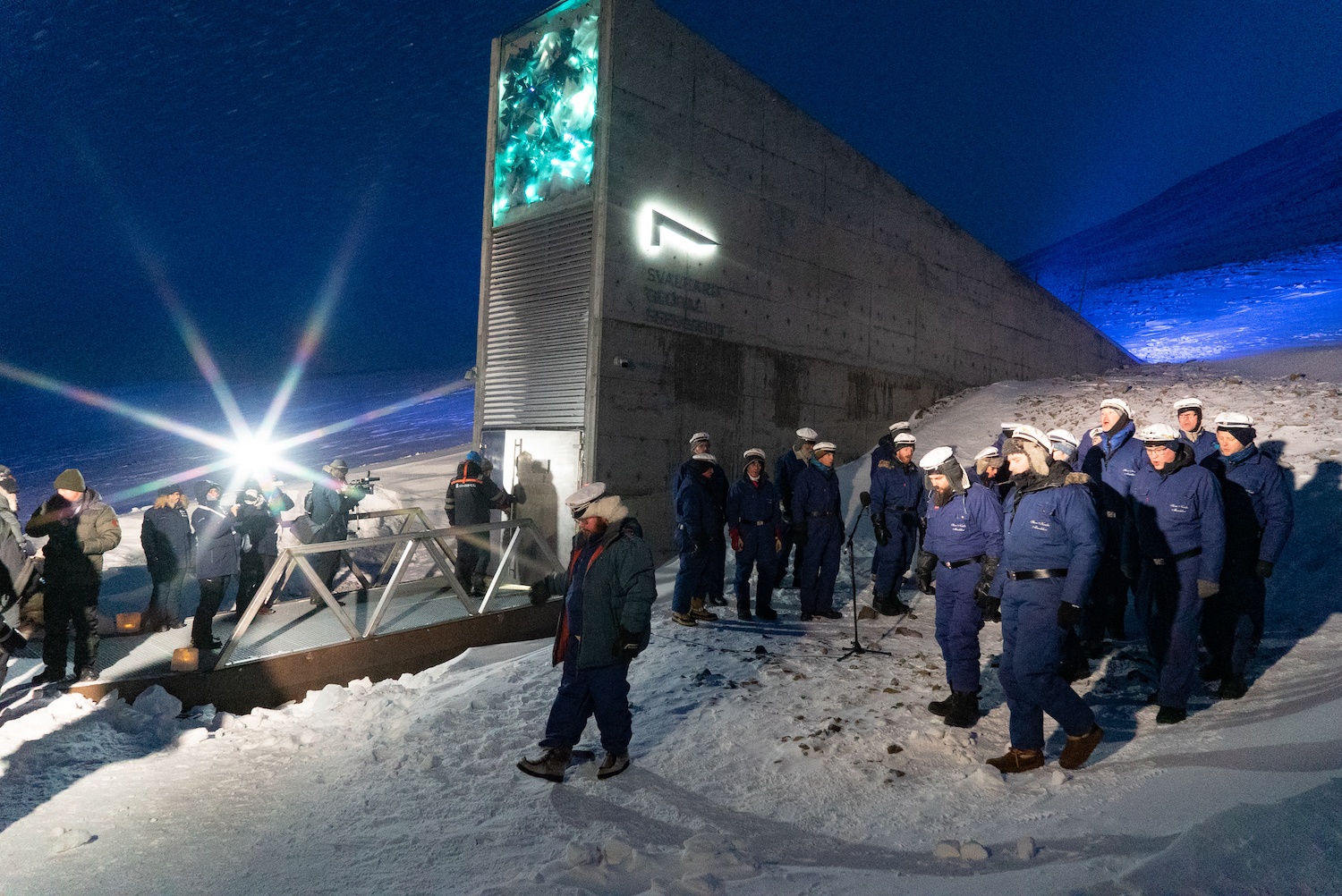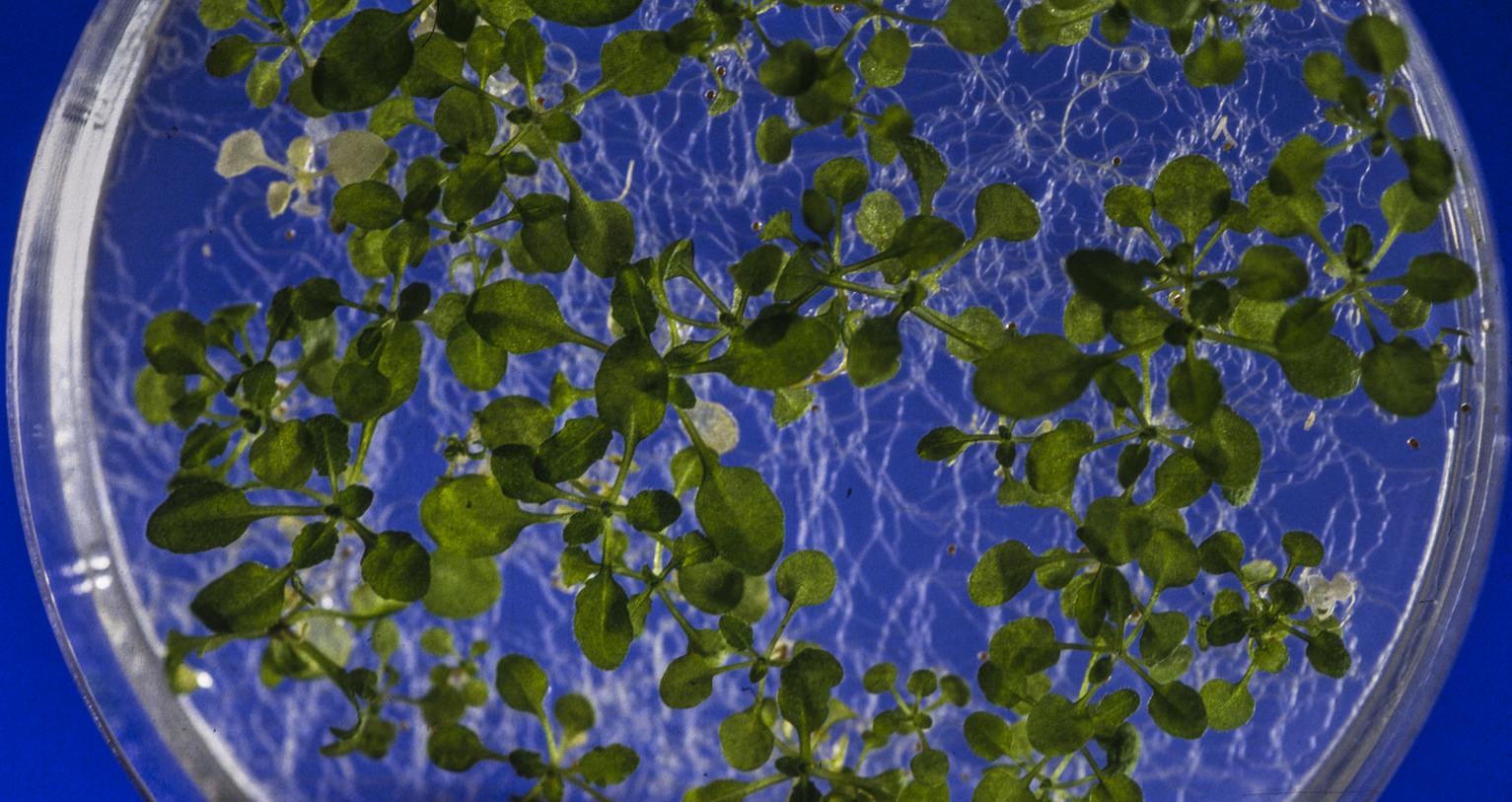
NordGen
In March, plant physiologist Stephanie Greene zipped herself into a padded snowsuit made to withstand sub-zero temperatures and trudged from a shuttle van parked at the bottom of an icy hill to the Svalbard Global Seed Vault—a small, secure site chiseled into rock and buried under permafrost about 650 miles from the North Pole. Outside the entrance, in the blistering cold, she stood shoulder-to-shoulder with a group of other conservationists from a range of home nations—from Morocco and Romania to the Philippines and Zambia—to make a historic deposit of diverse seeds: some of which are central to our diet, others that rare, all of which are precious. These offerings would join the facility’s “library of life,” a collection now topping over 1 million seeds from 85 different global seed collections, intended to secure our future food supply.
Pictured above, a Norwegian choir singing “Ja, vi elsker dette landet” (Norwegian National Anthem) at Svalbard Global Seed Vault deposit ceremony.
“To be surrounded by colleagues from all over the world who understand the importance of securing our genetic resources,” Greene said, “was a highlight of my life.”
As the day turned to dusk, a choir sang and Erna Solberg, the prime minister of Norway, began to call collectors forward to hand over plastic tubs and cardboard boxes of seeds. It was a moment Greene describes as “sacred”—one that reminded her why she fights so hard to preserve and sustain plant species that might otherwise be lost.

USDA’s Stephanie Greene accepting seed deposit certificate from Her Excellency Erna Solberg, prime minister of Norway
Ragnhild Utne for Svalbard Global Seed Vault
Since the dawn of agriculture, humans have saved seeds, roots, and other kinds of genetic material, modifying them in attempts to make the foods we consume more prolific, resilient, and delicious. Over centuries, these efforts have gotten more sophisticated, but a single theme endures: Having access to a broad range of genetic traits allows us to meet the challenges we face in growing and raising food. Scientists, farmers, and food companies rely on genetic diversity to breed new varieties that increase yields, make crops more nutritious or climate-tolerant, and mitigate the pests and diseases that ravage plant and animal populations—the sudden, devastating outbreaks that are not dissimilar from our current human pandemic.
Although entities throughout the world conserve a wide range of materials for food and agriculture (ranging from baker’s yeast to honeybee semen), seeds are the foundation of most stored collections, and the only material stored at the Global Seed Vault. Co-managed by the Norwegian government, the Crop Trust, and the Nordic Genetic Resource Center (NordGen), the facility is intended to back up important seed collections from the world’s roughly 2,000 seedbanks. These seeds are precious, the foundations of every meal we eat—from produce, pulses, and grains to the feed that nourishes livestock. What Greene and her conservationist colleagues deposited during the historic event in Svalbard is genetic material that’s now protected and will, hopefully, help ensure food security for generations to come.
The stakes are extremely high—which is why, for decades, conservationists have gone to great lengths to preserve these diverse varieties. For Greene and many of her colleagues, one example in particular underscores the importance of their work.
“I can understand why people died protecting their collections during the Leningrad siege. I have those same feelings.”
During the 1941 siege of Leningrad (in what is now St. Petersburg, Russia), as Nazis bombarded the city and residents teetered on the brink of starvation, a group of scientists locked themselves in the basement of the Vavilov Research Institute of Plant Industry to protect nearly half a million seeds and other plant materials. For weeks, they worked in shifts, shielding the collection from intruders, rodents, and the beasts of their own hunger. They eventually starved, choosing to die rather than eat the species they’d sworn to preserve. “The curator of the rice collection died surrounded by bags of rice,” Cary Fowler, the former executive director of the Crop Trust wrote, in 2010. “Scientists Kameraz and Voskresenskaia succumbed, protecting their potatoes to the very end.”
After the ceremony finished, Greene echoed that same dedication: “I can understand why people died protecting their collections during the Leningrad siege. I have those same feelings.”
—

The Svalbard Global Seed Vault has the capacity to store up to 4.5 million varieties of crops.
Ragnhild Utne for Svalbard Global Seed Vault
Greene works at the National Laboratory for Genetic Resources Preservation, the security backup system for all domestic collections—the Svalbard Seed Vault of the United States. Its impressive repository holds about 80 percent of the plant, animal, and microbial material stored in 17 genebanks spread across the 50 U.S. states and Puerto Rico.
It was there, in the chilly recesses of a beige building on the Colorado State University campus, that Greene—the facility’s supervisory plant physiologist and seed curator—and her colleagues prepped seeds for Svalbard. “We focus on sending material that’s unique to the United States,” she said. “What facilities around the country will do is look for unique accessions, make sure they are clean [disease-free] and dry, and send them to us here in Fort Collins.”
From there, Greene and her team repackage the seeds to last, well, forever—sealing samples inside special, extra heavy duty, tri-laminate aluminum foil packets. “They are heavier than what we use at our facility because the seeds we’re sending up to Svalbard are going to be there for quite some time.”

Seed Savers Exchange
In addition to USDA, Seed Savers Exchange and Cherokee Nation have also sent seeds from the U.S. to the Svalbard Global Seed Vault
The Laboratory has been sending seeds to the Seed Vault about every two years, but this was Greene’s first trip. The landscape of food has always been in constant motion—but as it become increasingly constrained around a few commodity species, and as new environmental challenges mount, a deep well of genetic varieties is more necessary than ever.
“Breeders are constantly having to address these issues of new diseases, new pests, climate change, changes in processed food and in processing techniques, in dietary preferences and nutritional quality—a whole host of things,” she said. “And it’s not like they are going to invent genes and traits to address these changes and challenges. They have to turn to existing plants that have attributes that they’re now interested in. That’s why this reservoir of diversity is so valuable.”
Countless real-world examples illustrate this point. In the late 1800s, for example, a tiny yellow-green insect called phylloxera devastated the French wine industry. The microscopic aphid likely hitched a ride from North America to Europe on the boots of a vintner or through an imported plant, and was soon feasting on the roots and leaves of grapevines in Provence. Because French grape plants had not built up any resistance to the bug, over just five years, nearly half of French vineyards were lost and neighboring wine-producing regions including Spain, Italy, and Germany were threatened. The crop was eventually saved by wine grape rootstock imported from the United States—plants that secreted a sap that thwarted the insects’ attack. By the 1890s, all French scions (grape shoots with buds) had been successfully grafted onto phylloxera-resistant American rootstock. The effort was eventually replicated throughout Europe and on all Old World vines that had been imported to the United States.
“Breeders are constantly having to address issues of new diseases, new pests, climate change, changes in processed food and in processing techniques, in dietary preferences and nutritional quality—a whole host of things.”
More recently, wheat rust—a set of fungal diseases known as the “polio of agriculture”—have been slowed by resistant genes found in the wheat collection stored and bred at CIMMYT, the International Maize and Wheat Improvement Center in El Batán, Mexico. The fungus has been around since the mid-1900s but, in 1999, a “super-race” of wheat rust surfaced in Uganda. That strain “had the ability to take out most of the resistance that was being used in wheat throughout the world,” CIMMYT senior scientist Dave Hodson explained, on the Cornell University podcast Plantopia, “It was capable of complete crop loss in just a few weeks.” Like the flu virus, wheat rust keeps mutating, which is why researchers continue to turn to the traits found in stored collections for help. (CIMMYT’s wheat collection contains over 140,000 varieties of wheat from more than 100 countries and is the largest unified collection of wheat in the world.)
Plant epidemics are what encouraged USDA to bulk up its collections when, in 1970, corn leaf blight (a set of diseases caused by airborne fungi) threated to decimate one of our foundational foods. In one year, Southern corn leaf blight wiped out one-fourth of American corn resulting in losses of around $1 billion. “Globally, there was this recognition that a lot of plant materials—traditional varieties and stuff—were on the verge of being lost,” Greene said. “But in the United States, corn leaf blight really brought home the fact that, ‘Uh oh, we are genetically vulnerable.’”
Up until that point, the USDA collections, established in the mid-1800s, were primarily seen as a way to bolster rural economies and expand domestic agriculture. The Department of Agriculture had dispatched hundreds of explorers around the world to find plant varieties that could thrive in the United States. The seeds were distributed to agronomists, universities, extension agents, and farmers who grew them into plants and observed how they responded. “They wanted to know how the seeds would respond in different environments,” Greene explained. “‘Did the plant work in South Dakota or was it a better variety to grow in New York?”

Seed shipment ready to be processed by NordGen and entered into the Svalbard Global Seed Vault
NordGen
This is how American agriculture took root: seed by seed and plant by plant.
But when corn leaf blight obliterated corn fields across the U.S., USDA’s efforts took on a new sense of urgency. In response, the organization launched the National Plant Germplasm System and expanded genebanks as a “hedge” against this vulnerability. Scientists and farmers worked together to incorporate new varieties alongside the more traditional ones to bolster the genetic base of the country’s commercial crops.
—

Deposit by Martin Kropff, Director General of the International Maize and Wheat Improvement Center in El Batán, Mexico
Crop Trust
Yet, despite this growing awareness, the industrialized system continues to favor uniformity over genetic variety. Last year, the Food and Agriculture Organization (FAO) released a landmark report on agricultural biodiversity that found, of the roughly 6,000 plant species used for food, only nine account for two-thirds of the world’s crop production. This contraction isn’t limited to produce: Most of our milk, meat, and eggs come from just a handful of animal species, which is why more than one-fourth of 8,000 local breeds of livestock are at risk of extinction. Our global diet has grown increasingly homogenized—a shaky foundation built on soybean and palm oil, plus wheat, rice, corn, and potatoes.
This loss is the result of myriad factors including climate change, pollution, urbanization, and a shift in our diets toward heavily-processed foods. But the biggest driver of change is how we use and manage our land and water, as farmers across the world are incentivized to industrialize their agricultural practices and grow genetically uniform, high-yielding crops over local plant varieties. Such management practices and land-use changes tend to undermine the strength and resiliency of food systems, FAO director general José Graziano da Silva wrote in the introduction to the organization’s report.
These decisions are made in favor of increased productivity—a single crop variety grown in monoculture allows for easier applications of inputs such as pesticides or fertilizer and greater efficiency in harvesting—but it leaves our food supply vulnerable to a variety of pests and diseases that can cause large-scale damage. The epidemics of phylloxera, wheat rust, and corn leaf blight weren’t anomalies.
There is evidence that decreasing biodiversity does not only make crops more vulnerable to disease—it can give rise to new human epidemics.
While these challenges, exacerbated by climate change and deforestation, are assured to continue, there is evidence that decreasing biodiversity does not only make crops more vulnerable to disease—it can give rise to new human epidemics. That’s according to a new study on the spillover of viruses from animal hosts to humans led by Christine Kreuder Johnson, professor of epidemiology and ecosystem health at the University of California, Davis. “Exploitation of wildlife through hunting and trade facilitates close contact between wildlife and humans,” the study’s authors write. “That exploitation, as well as anthropogenic activities that have caused losses in wildlife habitat quality, have increased opportunities for animal–human interactions and facilitated zoonotic disease transmission.”
There are additional rumblings of where these new transmissions might come from. Researchers from the University of Sheffield in the U.K., just published a paper in Proceedings of the National Academy of Sciences on Campylobacter jejuni, the world’s most common food-born bacterial pathogen. The authors suggest the overuse of antibiotics, low genetic diversity, and high concentration of animals in intensive chicken and cattle farming may increase the risk of pathogen spillover. “In the context of increasingly intensive farming practices and extensive global trade networks,” they write, “the shifting nature of livestock pathogens presents a major public health threat.”
“Coronavirus is showing us just how vulnerable we are,” Greene said, with a sigh. But it also where the conservationists come in.

Svalbard Global Seed Vault, the backup repository for duplicates of seed samples that are conserved in genebanks all over the world
Riccardo Gangale for Svalbard Global Seed Vault
Greene has worked within the USDA genebank system since 1992. She knows the resources needed to properly safeguard genetic resources for food and agriculture—both in the United States and abroad—are lacking. But as we, the eating public, become more aware of the importance of agricultural biodiversity, we also have the opportunity to take part in sustaining it.
We tend to conserve biodiversity in three ways: by building stored collections, like seed banks; by protecting biodiverse places, like rainforests; and by growing and raising diverse varieties on farms. In my book, Bread, Wine, Chocolate: The Slow Loss of Foods We Love, I suggested a fourth approach: to save biodiverse foods by savoring them—by seeking out heirloom fruit or ancient grains, or maybe planting a few unfamiliar seeds. Through our consumption or cultivation, we can all participate in sustaining less common plant species and varieties—a contribution that helps to reinforce the work of professional conservationists like Greene.
“I was collecting wild crops in Kazakhstan,” she recalled, “and stumbled on to some farmer’s field.” The farmer was angry the plant collectors had stumbled onto his property and chased them off with a rifle. “Of course, we backed away and left. But my sense was, if I die collecting seed, that’s okay. I know it’s really corny, but I’m doing something worthwhile. I have a PhD in plant breeding, and a visceral understanding of how important genetic diversity is in improving crops and putting food on the table. That’s why, decades later, I’m still here.”
Correction: This article misstated Cary Fowler’s former role as executive director of the Seed Vault, rather than the Crop Trust.








